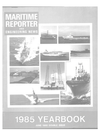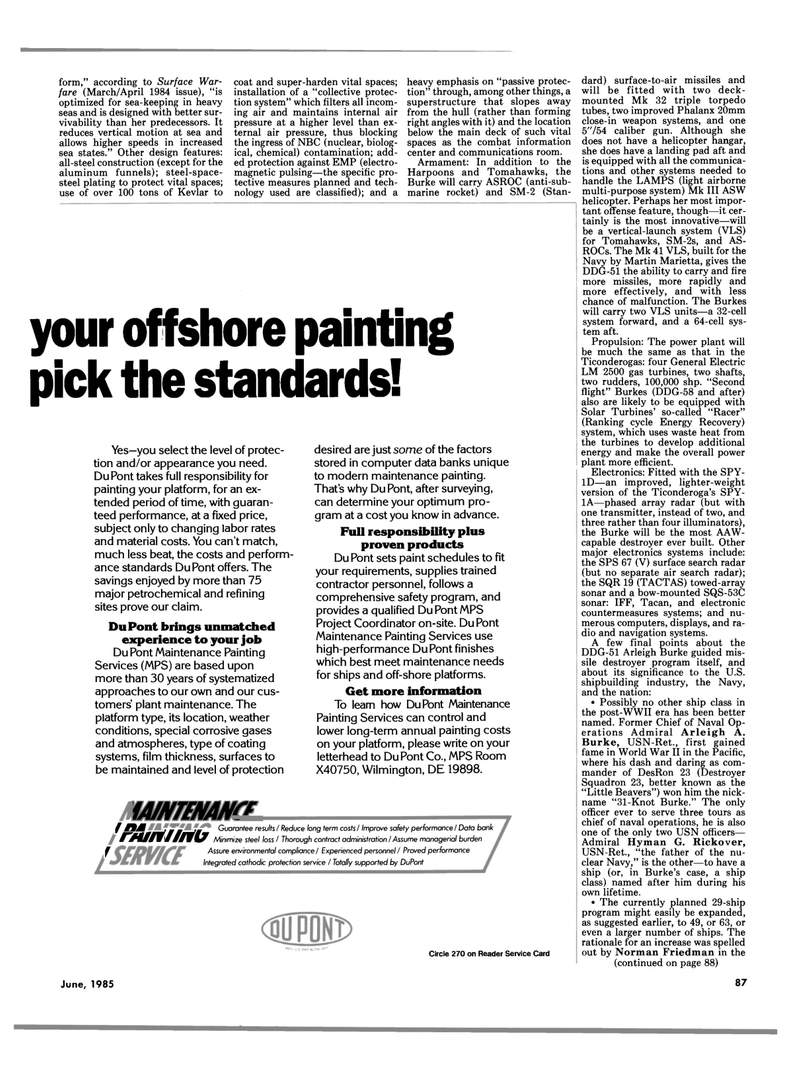
Page 89: of Maritime Reporter Magazine (June 1985)
Read this page in Pdf, Flash or Html5 edition of June 1985 Maritime Reporter Magazine
form," according to Surface War- fare (March/April 1984 issue), "is optimized for sea-keeping in heavy seas and is designed with better sur- vivability than her predecessors. It reduces vertical motion at sea and allows higher speeds in increased sea states." Other design features: all-steel construction (except for the aluminum funnels); steel-space- steel plating to protect vital spaces; use of over 100 tons of Kevlar to coat and super-harden vital spaces; installation of a "collective protec- tion system" which filters all incom- ing air and maintains internal air pressure at a higher level than ex- ternal air pressure, thus blocking the ingress of NBC (nuclear, biolog- ical, chemical) contamination; add- ed protection against EMP (electro- magnetic pulsing—the specific pro- tective measures planned and tech- nology used are classified); and a heavy emphasis on "passive protec- tion" through, among other things, a superstructure that slopes away from the hull (rather than forming right angles with it) and the location below the main deck of such vital spaces as the combat information center and communications room.
Armament: In addition to the
Harpoons and Tomahawks, the
Burke will carry ASROC (anti-sub- marine rocket) and SM-2 (Stan- your offshore painting pick the standards!
Yes—you select the level of protec- tion and/or appearance you need.
Du Pont takes full responsibility for painting your platform, for an ex- tended period of time, with guaran- teed performance, at a fixed price, subject only to changing labor rates and material costs. You can't match, much less beat, the costs and perform- ance standards Du Pont offers. The savings enjoyed by more than 75 major petrochemical and refining sites prove our claim.
DuPont brings unmatched experience to your job
Du Pont Maintenance Painting
Services (MPS) are based upon more than 30 years of systematized approaches to our own and our cus- tomers' plant maintenance. The platform type, its location, weather conditions, special corrosive gases and atmospheres, type of coating systems, film thickness, surfaces to be maintained and level of protection desired are just some of the factors stored in computer data banks unique to modern maintenance painting.
That's why Du Pont, after surveying, can determine your optimum pro- gram at a cost you know in advance.
Full responsibility plus proven products
Du Pont sets paint schedules to fit your requirements, supplies trained contractor personnel, follows a comprehensive safety program, and provides a qualified Du Pont MPS
Project Coordinator on-site. DuPont
Maintenance Painting Services use high-performance DuPont finishes which best meet maintenance needs for ships and off-shore platforms.
Get more information
To learn how DuPont Maintenance
Painting Services can control and lower long-term annual painting costs on your platform, please write on your letterhead to DuPont Co., MPS Room
X40750, Wilmington, DE 19898.
WNTENANCL f DMGuarantee results/ Reduce long term costs / Improve safety performance/ Data bank rMinllnU,
Minimize steel loss / Thorough contract administration / Assume managerial burden ssure environmental compliance / Experienced personnel / Proved
Integrated cathodic protection service / Totally supported by DuPont fAssure environmental Proved performance
Circle 270 on Reader Service Card dard) surface-to-air missiles and will be fitted with two deck- mounted Mk 32 triple torpedo tubes, two improved Phalanx 20mm close-in weapon systems, and one 5"/54 caliber gun. Although she does not have a helicopter hangar, she does have a landing pad aft and is equipped with all the communica- tions and other systems needed to handle the LAMPS (light airborne multi-purpose system) Mk III ASW helicopter. Perhaps her most impor- tant offense feature, though—-it cer- tainly is the most innovative—will be a vertical-launch system (VLS) for Tomahawks, SM-2s, and AS-
ROCs. The Mk 41 VLS, built for the
Navy by Martin Marietta, gives the
DDG-51 the ability to carry and fire more missiles, more rapidly and more effectively, and with less chance of malfunction. The Burkes will carry two VLS units—a 32-cell system forward, and a 64-cell sys- tem aft.
Propulsion: The power plant will be much the same as that in the
Ticonderogas: four General Electric
LM 2500 gas turbines, two shafts, two rudders, 100,000 shp. "Second flight" Burkes (DDG-58 and after) also are likely to be equipped with
Solar Turbines' so-called "Racer" (Ranking cycle Energy Recovery) system, which uses waste heat from the turbines to develop additional energy and make the overall power plant more efficient.
Electronics: Fitted with the SPY-
ID—an improved, lighter-weight version of the Ticonderoga's SPY- 1A—phased array radar (but with one transmitter, instead of two, and three rather than four illuminators), the Burke will be the most AAW- capable destroyer ever built. Other major electronics systems include: the SPS 67 (V) surface search radar (but no separate air search radar); the SQR 19 (TACTAS) towed-array sonar and a bow-mounted SQS-53C sonar: IFF, Tacan, and electronic countermeasures systems; and nu- merous computers, displays, and ra- dio and navigation systems.
A few final points about the
DDG-51 Arleigh Burke guided mis- sile destroyer program itself, and about its significance to the U.S. shipbuilding industry, the Navy, and the nation: • Possibly no other ship class in the post-WWII era has been better named. Former Chief of Naval Op- erations Admiral Arleigh A.
Burke, USN-Ret., first gained fame in World War II in the Pacific, where his dash and daring as com- mander of DesRon 23 (Destroyer
Squadron 23, better known as the "Little Beavers") won him the nick- name "31-Knot Burke." The only officer ever to serve three tours as chief of naval operations, he is also one of the only two USN officers—
Admiral Hyman G. Rickover,
USN-Ret., "the father of the nu- clear Navy," is the other—to have a ship (or, in Burke's case, a ship class) named after him during his own lifetime. • The currently planned 29-ship program might easily be expanded, as suggested earlier, to 49, or 63, or even a larger number of ships. The rationale for an increase was spelled out by Norman Friedman in the (continued on page 88)
June, 1985 87

 88
88

 90
90
